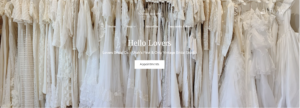Vintage wedding dresses: Remember playing dress-up and it always seemed to be that yellowed, “outdated” lacey dresses and clothing? The kind that always had that slightly musty scent and were supposed to be closer to white in color than yellow?
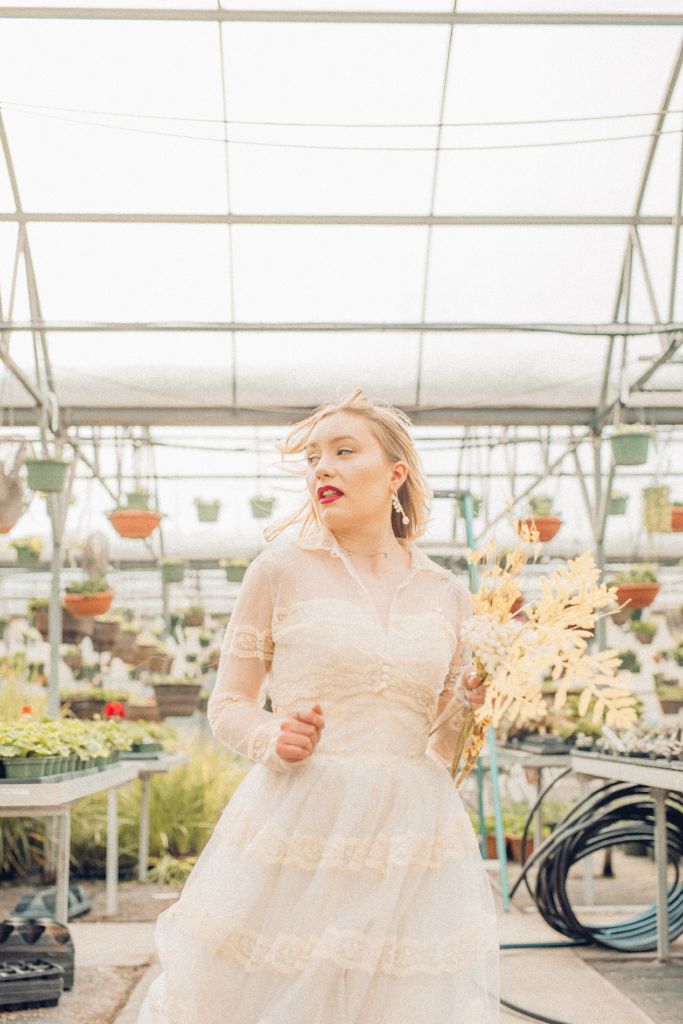
I am shocked to say that I am looking at some of those same dresses now and eyes light up, stars twinkling in them as I think—wow, what a wedding dress that would make!
Yes, vintage inspired wedding dress styles are trending, and actual vintage wedding dresses too. What are the trends, how do you take that inspiration or work with a vintage wedding dress to make it something magical and NOT look like your playing “dress-up” with outdated clothes?
Well, we’re here to help you out 😉
Trends Tend to Fluctuate… And We’re in Our Opulent, Romantic Era Again (All Heart Eyes Over Here)
Bridal fashion is no different than other fashion—trends come and go and fashion is often “recycled” to reflect what is going on in our world: social and cultural changes. Wedding dress trends have gone back and forth between sleeker, more modern styles and more traditional, romantic styles over the decades since the 1920s.
For example, the flapper style of the 1920s was a reaction to the conservative styles of the previous decade, while the elegant, romantic styles of the 1930s and 1940s reflected the desire for a return to traditional values during the Depression and World War II.
In the 1950s, wedding dresses became more extravagant and feminine, reflecting the post-war boom and the rise of Hollywood glamour. Then in the 1960s, wedding dresses became more minimalist and modern, reflecting the cultural shifts of the time.
Since then, wedding dress trends have continued to alternate between sleek, modern styles and more traditional, romantic styles. For example, the 1980s saw the rise of the big, voluminous wedding dress, while the 1990s and 2000s saw a return to simpler, more streamlined styles. In recent years, there has been a resurgence of interest in vintage styles, including both sleek and traditional designs from past decades.
Currently, wedding and fashion is back into its over-the-top, statement, individualistic, romantic era (I say an ode to the 70’s and 80’s)—and its just what we needed.
Vintage Wedding Dresses: Style & Inspiration Throughout the Decades
So if they have fluctuated, how do we know what eras are influencing us now? Let’s take a brief history tour of some of the wedding fashion styles throughout the decades, and that decade’s key features.
Victorian Era (1837-1901): The Emergence of White Dresses & Full Skirts
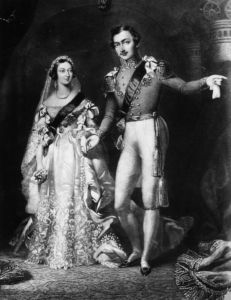
Queen Victoria had a significant influence on the style of wedding dresses during the Victorian era. And you are still seeing her impact today.
In 1840, Queen Victoria married Prince Albert in a white wedding dress, which was a departure from the traditional royal wedding attire of the time. The dress was made of white silk satin and was trimmed with lace, and it featured a full skirt and a bodice with a pointed waist.
The Queen’s wedding dress set a trend for white wedding dresses that lasted throughout the Victorian era and beyond. Prior to this, brides typically wore dresses in a variety of colors, including red, blue, and even black However, after Queen Victoria’s wedding, white became the most popular color for wedding dresses in the Western world. It became a symbol of purity, wealth, and rarity. Personally, this is where I am like NOOOOO because I love color, but I think we’ll see that change here.
In addition to the color, Queen Victoria’s dress also influenced the overall style of wedding dresses during the Victorian era. The dress was designed with a full skirt and a fitted bodice, which emphasized the waist and created a flattering silhouette. This style became popular for wedding dresses, and it was often paired with long sleeves and high necklines.
Overall, Queen Victoria had a significant impact on the style of wedding dresses during the Victorian era, as her own wedding dress set a trend for white wedding dresses and influenced the overall design of wedding dresses during the period.
Victorian-style wedding dresses are known for their high necklines, long sleeves, and full skirts. They often feature lace, embroidery, and other intricate details.
Edwardian Era (1901-1910)
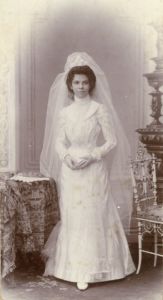
Edwardian-style wedding dresses are characterized by their flowing lines, loose bodices, and high waistlines. They often feature delicate fabrics such as silk or chiffon, and may have lace, tulle, or other embellishments.
Several factors influenced the style of wedding dresses during the Edwardian era, but the two most significant were:
Art Nouveau
The Art Nouveau movement was at its height during the Edwardian era, and it heavily influenced fashion and design during the period. Art Nouveau design is characterized by flowing lines, curves, and organic shapes, and these elements can be seen in many Edwardian wedding dresses. Wedding dresses during this time were often designed with soft, flowing fabrics, and they featured intricate lacework and delicate embroidery.
Women’s suffrage
The women’s suffrage movement was gaining momentum during the Edwardian era, and this had a significant impact on fashion, including wedding dress trends. Women began to reject the restrictive and uncomfortable clothing of the past and embraced more practical and comfortable styles. Wedding dresses during this time were often designed with simpler lines and more comfortable fabrics, such as lightweight silk or cotton. They were also often shorter than previous styles, allowing for greater ease of movement.
We see that an overlap of practicality and comfort flowed into the 1920’s & 1930’s, but they dared to move beyond continuous and flowy shapes into geometric lines.
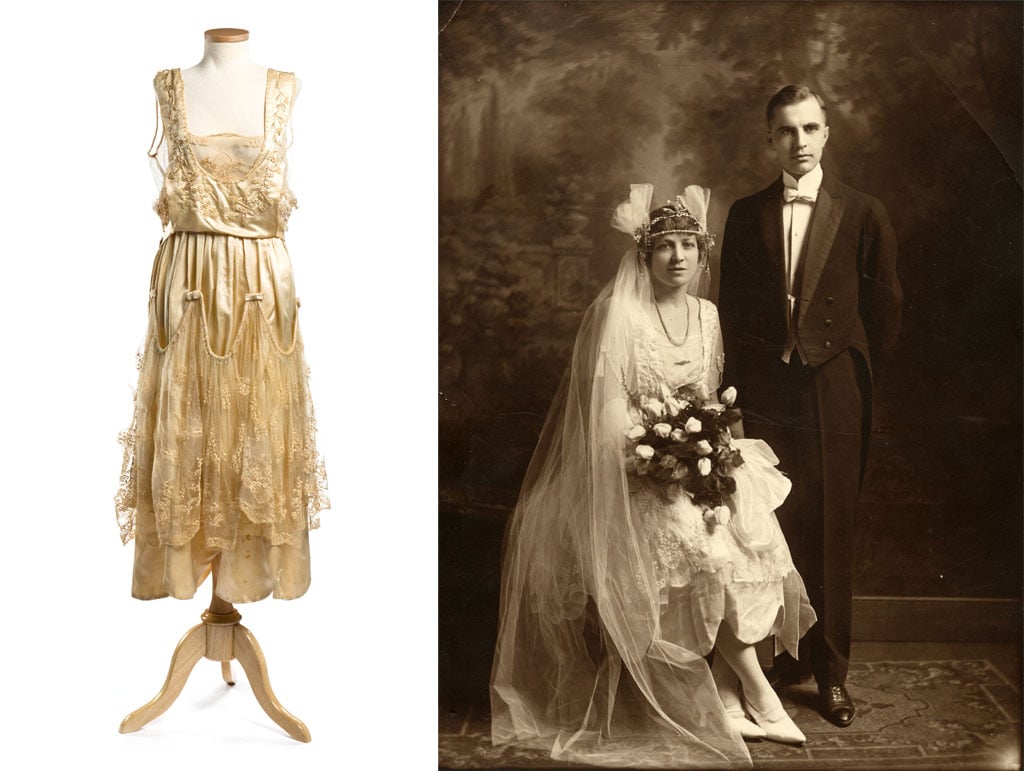
1920s
Art Deco and “flapper” dresses, jazz and women’s liberation—fashion was influenced by a sense for liberation and a little ode to luxury with ornate embellishments without being too over the top.
The Art Deco movement was at its height in the 1920s, and it heavily influenced fashion and design during the decade. Art Deco design is characterized by geometric shapes, bold lines, and ornate embellishments, which can be seen in many 1920s wedding dresses.
The 1920s are often referred to as the Jazz Age, as jazz music and dancing became popular during this time. This cultural movement had an impact on fashion, as dresses were designed to allow for greater freedom of movement and more comfort on the dance floor. But as well, the women’s liberation movement pushed for style changes that were more practical in design, such as aiding in being able to dance.
You’ll see a lot of 1920’s dresses are typically shorter than other wedding dresses and feature dropped waistlines, low necklines, and loose, flowing skirts. They often have beaded or sequined detailing. You can see how these designs were an opportunity to be ornate and still break away from the traditional restraints in women’s wedding dresses.
Essentially, 1920’s has been described as one of the most dramatic departures from traditional wedding dresses.
1930’s
1930s-style wedding dresses are characterized by their bias-cut silhouettes, which create a figure-hugging fit. They often feature long sleeves, high necklines, and luxurious fabrics such as silk or satin.
1940’s
1940s-style wedding dresses often have a fitted bodice and a full skirt. They may feature square necklines, short or long sleeves, and lace or beaded detailing. The military style penetrated into the fashion world by bringing in the military style jackets and bodices fitted with shoulder pads to “bulk up” women’s frames.
![1950s Vintage Wedding Dresses & Shoes History | Wedding dresses vintage, Wedding gowns vintage, 1950s wedding dress]() 1950’s
1950’s
1950s was a decade where many longed for a previous era of stability and was rooted in the notion of countries of tradition—and so were inspired by traditional, feminine styles. 1950-style wedding dresses are known for their full skirts, fitted bodices, and sweetheart necklines. They often have layers of tulle or other fabrics to create a dramatic effect.
The biggest style of wedding dress known from the 1950’s was the “tea gown.”
![Penneys catalog 60s | Vintage bridal fashion, Wedding gowns vintage, Wedding dress styles]() 1960’s
1960’s

Think of the term ‘mod’: a very 60’s word with a 60’s connotation to just those things. Some of the key features of 1960s wedding dresses include:
- Mod silhouette: The mod silhouette was very popular in the 1960s and was characterized by a simple, streamlined shape. Wedding dresses of this era often featured a straight or A-line silhouette with minimal ornamentation.
- Short hemlines: The 1960s was a time of rebellion and experimentation, and many brides chose to wear short wedding dresses that hit above the knee.
- High necklines: Wedding dresses of the 1960s often had high necklines, which were a departure from the low-cut styles of the 1950s.
- Sleeves: Sleeves were optional in 1960s wedding dresses, and many brides opted for sleeveless or cap-sleeve styles.
- Bold colors: While traditional white wedding dresses were still popular, some brides opted for bold colors like pink, blue, or even black.
- Mod details: Mod details like geometric patterns, bold buttons, and metallic embellishments were also popular in 1960s wedding dresses.
1960s wedding dresses were simple, elegant, and modern, with a focus on clean lines and minimal ornamentation.
![The mid to late 1970s was the emergence of Peasant and Prairie Revival fashion.. While desig… | 1970s wedding dress, Wedding gowns vintage, Wedding dresses vintage]() 1970’s
1970’s
Wedding dress styles in the 1970s were influenced by a sense of liberation, experimentation, and individuality. This makes sense when you think about what was going on during that timeframe: a call for the end of the Vietnam War, political unrest, society ready for a revolution. Here are some defining characteristics of 1970s style wedding dresses:
- Bohemian Influence: The bohemian trend of the 1960s continued into the 1970s, and boho-inspired wedding dresses were popular during this era. These dresses often featured flowing fabrics, floral details, and a relaxed, effortless vibe.
- Sheer and Flowy: 1970s wedding dresses often featured sheer or flowy fabrics, such as chiffon, organza, or lace. These fabrics were used to create dreamy, ethereal silhouettes that were often loose and unstructured.
- High Necklines and Long Sleeves: Modesty was a key feature of many 1970s wedding dresses, which often featured high necklines and long sleeves. You can see that the high necklines had continued you through from the 1960’s but in a different way. These dresses were often made of heavier fabrics, such as velvet or brocade, and were sometimes adorned with intricate beading or embroidery.
- Earthy Colors: While white wedding dresses were still popular in the 1970s, many brides opted for dresses in earthy tones such as ivory, cream, or beige. Some brides even wore dresses in unconventional colors, such as pale pink or blue.
- Non-Traditional Silhouettes: In keeping with the spirit of experimentation and individuality, 1970s wedding dresses often featured non-traditional silhouettes. Some dresses were short or midi-length, while others were designed with high-low hemlines or asymmetrical cuts.
Overall, 1970s style wedding dresses were characterized by a sense of freedom, individuality, and experimentation. They often featured unconventional fabrics, colors, and silhouettes, and were designed to reflect the bride’s unique personality and style.

- Romanticism: The 1970s was a time when fashion trends were heavily influenced by the romanticism of the past. Lace has always been associated with romance, delicacy, and femininity, making it a natural choice for wedding dresses.
- Bohemian Influence: The bohemian trend of the 1960s continued into the 1970s, and many wedding dresses of the era featured bohemian-inspired lace designs. This lace was often used to create a dreamy, ethereal look that was popular in the bohemian aesthetic.
- Vintage Influence: The 1970s also saw a resurgence of interest in vintage fashion, particularly from the Victorian and Edwardian eras. Lace was a popular fabric during these eras, and many 1970s wedding dresses featured lace designs inspired by these vintage styles.
- Practicality: While lace may seem like a delicate and fragile fabric, it is actually quite durable and easy to care for. This made it a practical choice for wedding dresses, which need to withstand a long day of wear and tear.
- Versatility: Lace is a versatile fabric that can be used in a variety of ways, from delicate overlays to intricate appliques. This versatility allowed designers to create a wide range of lace designs that could appeal to different styles and tastes.
Overall, the intricate lace designs of 1970s wedding dresses were a reflection of the romantic, bohemian, and vintage influences of the era, as well as the practicality and versatility of the fabric.
In some ways, 1970s wedding dresses were more over-the-top than modern wedding dresses, while in other ways they were more understated. Here are some factors to consider:
- Silhouette: In the 1970s, wedding dresses often had more exaggerated silhouettes than modern dresses. Dresses were often voluminous and had layers of tulle or other fabrics to create a dramatic look. In contrast, modern wedding dresses tend to have a more streamlined silhouette.
- Details: 1970s wedding dresses often featured intricate lace designs, beading, and embroidery. These details could be quite elaborate and ornate, adding to the overall “over-the-top” look of the dress. While some modern wedding dresses also feature embellishments, they tend to be more understated.
- Color: While white wedding dresses were still popular in the 1970s, some brides chose to wear dresses in unconventional colors, such as pale pink, blue, or even black. This was seen as quite bold and daring at the time, and added to the overall “over-the-top” feel of the dress. In contrast, modern wedding dresses tend to stick to traditional white or ivory.
- Accessories: In the 1970s, brides often wore large flower crowns, long veils, and other accessories that added to the overall dramatic effect of the wedding dress. Modern brides tend to be more minimalist when it comes to accessories, often opting for a simple veil or statement jewelry instead.
While 1970s wedding dresses could be considered over-the-top in some ways, it is important to remember that fashion is always evolving, and what was once considered daring or unconventional can become more mainstream over time.
![40 years since her wedding, here's a look at all the details you never knew about Princess Diana's iconic bridal gown | Vogue India]() 1980’s
1980’s
I’d almost just summarize this era as the “Princess Diana Era”–much like how Queen Victoria changed the wedding dress world in the Victorian Era, Princess Diana’s impact is clearly evident in the 1980’s wedding dress styles.
Big Bows
Big bows on wedding dresses were a popular trend in the 1980s and early 1990s, and while they have been out of fashion for some time, we are starting to see a resurgence of this trend in modern bridal wear.
We have seen it mostly in taking bows and making them a statement part of the design. Little bows around the waist and back have started to pop-up in many bridal fashion designers pieces, but I have also noticed that oversized, almost abstract bows that flow from the fabric and dress are starting creep in.
I even feel that the bow is being used as inspiration for floral designs within dresses and accessories. Big floral statements are coming back in bouquets, lace design, and 3d texture.
![]() Big Puffy Sleeves
Big Puffy Sleeves
The big puffy sleeves on wedding dresses were popular in the 1980s as a reflection of the overall fashion trends of the decade. The 1980s were characterized by bold, dramatic styles with a focus on excess and opulence. The puffy sleeves on wedding dresses were part of this trend, as they added a sense of drama and extravagance to the overall design.
The popularity of big puffy sleeves can also be attributed to the influence of Princess Diana, who wore a wedding dress with large puffy sleeves for her wedding to Prince Charles in 1981. This iconic dress set the trend for wedding dresses in the 1980s and beyond, and many brides were inspired to incorporate similar styles into their own wedding dress designs.
Additionally, advances in fabric technology made it possible to create voluminous, structured sleeves that could hold their shape without adding bulk to the rest of the dress. This allowed designers to create exaggerated sleeve designs that were both practical and stylish.
Overall, the big puffy sleeves on wedding dresses in the 1980s were a reflection of the bold, extravagant style of the decade, as well as the influence of Princess Diana’s iconic wedding dress.
2023 Wedding Trends That Are Inspired from Vintage Wedding dResses
In 2023 I feel we are finally breaking free from the effects of the pandemic. We are finding ways to adapt, move on, and have re-evaluated what we want out of life and how we want to live. As a societal whole, we are leaning into the individuality and experimentation, just as people did in the 1970’s.
This means holding an elegance that is from one extreme to another, but also a step away from the 1950’s and Victorian styles (such as colored dresses making their comeback—woooo!).
I feel the 1970’s is the biggest source for inspiration right now because we are feeling ready for a revolution both politically and socially—just as many others from the 1970’s. Below are some trends in 2023 that have a large influence from the 1970’s:
- High Necks
- Lots of Lace & Details
- Ruffles & Unique Silhouettes
- Transparent Fabrics

In addition, we are seeing the 1980’s coming back into play in the following trends for wedding dresses in 2023:
- Big, puffy Sleeves
- Bows, bows, and more bows
- Over the top, intricate details, and layer of fabric
But Why the Resurgence of Vintage-Style & Actual Vintage Wedding Dresses?
What makes a vintage-style come back in style? I’d argue many people feel nostalgic for the past and are drawn to vintage styles as a way of connecting with a bygone era. As a world, we’re sick of the modern designs that lack that romanticism, and so are pulling from the past (even wearing vintage wedding dresses of the page). There are several other reasons why there has been a resurgence of interest in vintage-style wedding dresses in recent years:
- Sustainability: In recent years, there has been a growing awareness of the environmental impact of the fashion industry. Vintage wedding dresses are a sustainable and ethical choice, as they are recycled and do not contribute to the production of new materials.
- Individuality: Vintage wedding dresses offer a unique and individual look that stands out from the crowd. Many modern wedding dresses are mass-produced, while vintage dresses are often one-of-a-kind pieces that are truly unique.
- Timelessness: Vintage wedding dresses have a timeless quality that transcends fashion trends. They offer a classic and elegant look that will never go out of style.
- Cost: Vintage wedding dresses can often be found at a lower cost than new designer dresses. This can be an attractive option for couples who are looking to save money on their wedding expenses.
Interest in vintage wedding dresses can be seen as a reaction to the fast-paced, disposable nature of modern fashion. Vintage dresses offer a unique and sustainable alternative that allows couples to create a timeless and romantic wedding look.
How are vintage wedding dresses more sustainable?
Vintage wedding dresses are more sustainable than new wedding dresses because they are a form of clothing recycling. By purchasing a vintage wedding dress, you are giving new life to an existing garment instead of contributing to the production of new materials.
Here are some ways that vintage wedding dresses are more sustainable:
- Reducing waste: When you purchase a vintage wedding dress, you are preventing it from ending up in a landfill or being discarded. This helps to reduce textile waste and the environmental impact of the fashion industry.
- Saving resources: The production of new materials, such as fabrics and embellishments, requires a significant amount of energy, water, and other resources. By purchasing a vintage wedding dress, you are reducing the demand for these resources.
- Lowering carbon footprint: The production and transportation of new materials and finished garments contribute to greenhouse gas emissions. By choosing a vintage wedding dress, you are reducing your carbon footprint and the environmental impact of your wedding.
- Ethical concerns: The fashion industry is often criticized for exploitative labor practices, including low wages and poor working conditions. By purchasing a vintage wedding dress, you are not contributing to these unethical practices.
Overall, choosing a vintage wedding dress is a sustainable and ethical choice that can help to reduce waste and environmental impact while still allowing you to look beautiful on your wedding day.
How can I find an actual vintage wedding dress in Utah?
Wed Utah is working on providing wedding dress options across all of Utah for future brides. Amongst this, we noticed lots of bridal shops but not a lot of options for finding vintage wedding dresses that weren’t stained and dirty.
We’ve started investigating the process, and are now offering sourced vintage wedding dresses for rent or purchase. Check out our store to see our current collection of dresses.
As well, we were able to locate a local Salt Lake City vintage wedding dress company called Lovers Bridal Co. We will be making a trip to check out their store and give you the full run down of this awesome store!
If you want to do the investigating, research, and sourcing of a vintage wedding dress on your own—we suggest looking on Ebay, in local thrift stores, and local online marketplace groups. Keep in mind, many vintage wedding dresses may need repairs, have yellowing, and generally run in smaller sizes. As well, you most likely need to involve a tailor, particularly if you want to upsize a smaller vintage wedding dress.
We’ll add any updates as we continue to look for other sources and vendors for vintage wedding dresses in Utah.
Vintage Style Wedding Dresses: Connect with Trends of the Past to Create a New Future
In the end, vintage style wedding dresses show us trends that ode to a characteristic that resonates with you and your personality. With any fashion trend, it’s important to choose a style that you love and feel confident in, regardless of whether or not it’s currently in fashion.
We hope this vintage style wedding dresses guide can help you find an era and style that you better connect to, and bring out the story about you and your journey into a new chapter of life.
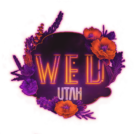

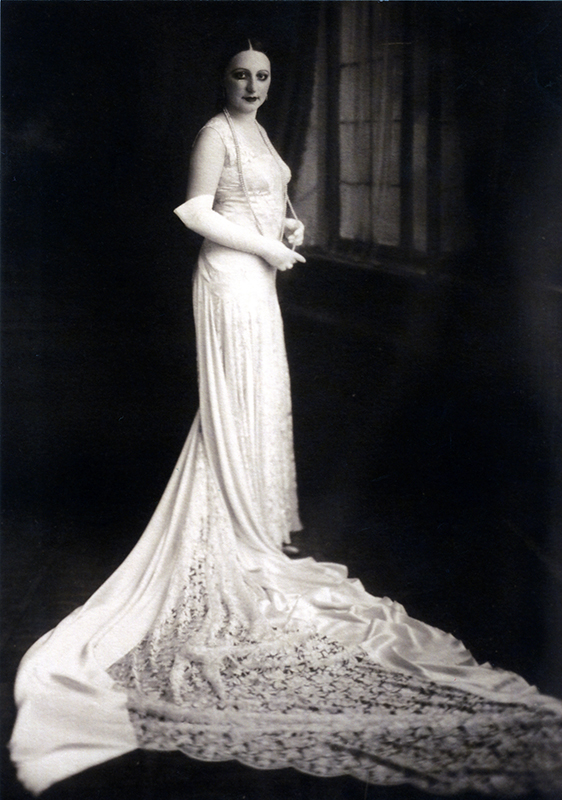
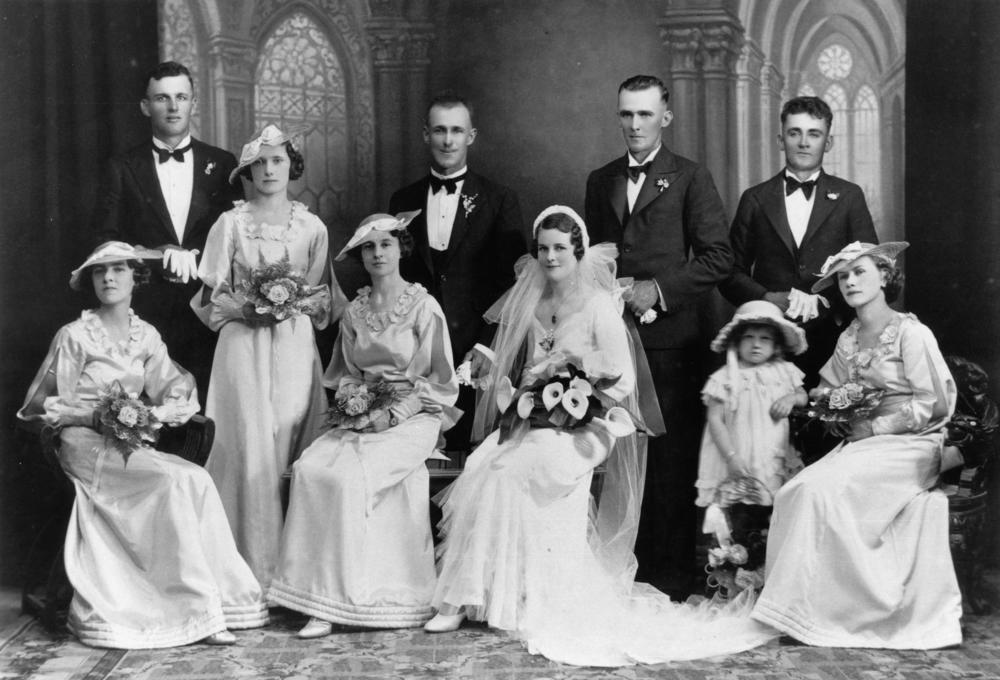
 1950’s
1950’s 1960’s
1960’s 1970’s
1970’s
 1980’s
1980’s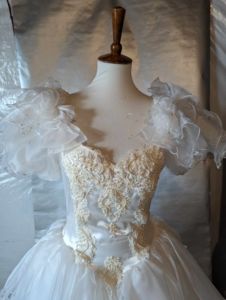 Big Puffy Sleeves
Big Puffy Sleeves